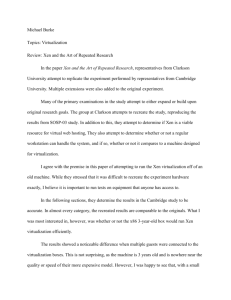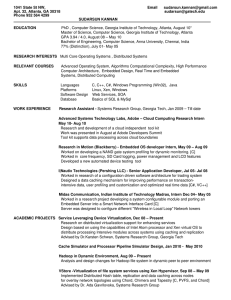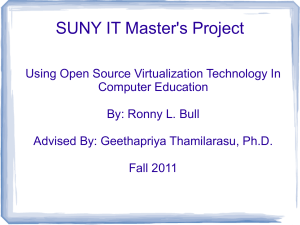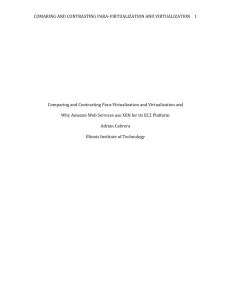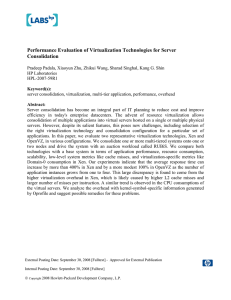Network Implementation for Xen and KVM Class project for E6998-01:
advertisement
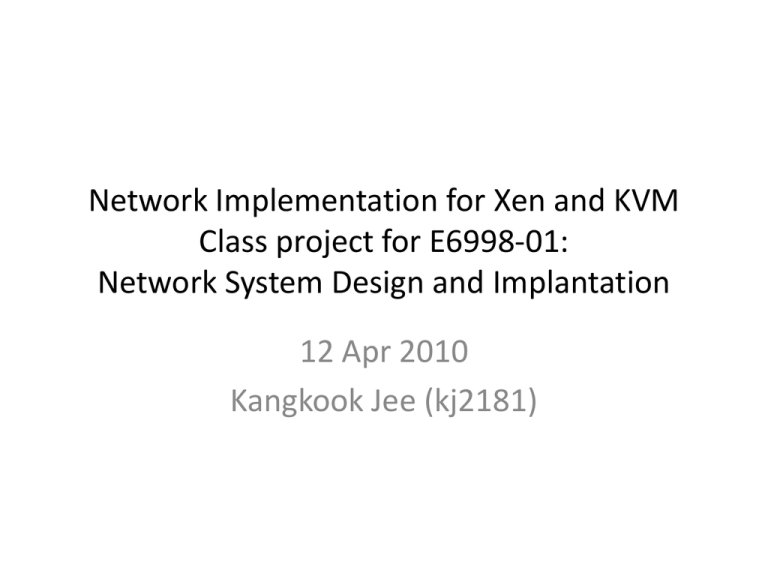
Network Implementation for Xen and KVM Class project for E6998-01: Network System Design and Implantation 12 Apr 2010 Kangkook Jee (kj2181) Project goal • Explore network implementation for 2 most popular open-source virtualization architectures – Xen, KVM (the Kernel-based Virtual Machine) – Demystifying each VMM’s network implementation • Performance analysis for network I/O – Compares Native OS, Xen, KVM – Test for RX, TX and identify bottlenecks Virtualization overview • Hosted Architecture – VMWare Workstation, VirtualBox .. • Hybrid Architecture (S/W hypervisor based) – VMWare ESX: Full-virtualization – Xen: Para-virtualization – KVM (the Kernel-based Virtual Machine) Reuse Linux code as much as possible – Tightly integrated into Linux • Hypervisor (H/W) Architecture – IBM s/390 … VMM architecture: VMWare • Full virtualization • Binary translation based - Full virtualization • Guest OS doesn’t aware of underlying VMM Source: http://www.vmware.com/pdf/esx2_performance_implications.pdf VMM architecture: Xen • Para-virtualization OSes • Dedicated control domain: DOM0 • Modified Guest OS - Linux Kernel (3K lines) - Windows XP (4.6 K lines) Devices • Front-end (Net-front) for Guest OS to communicate Dom0 • I/O channel (zero copy) • Backend (Net-back) for Dom0 to communicate with underlying systems Source: “An overview of Xen Virtualization” from Dell power solutions VMM architecture: KVM • Hypervisor tightly integrated into Linux code based QEMU QEMU QEMU • Hypervisor: Kernel module • Guest OS: User space process (QEMU for x86 emulation) • Need H/W virtualization extension Xen vs. KVM Xen • Strong support for paravirtualization with modified host-OS Near-native performance for I/Os • Separate code based for DOM0 and device drivers • Security model Rely on DOM0 • Maintainability Hard to catch up all versions of possible guests due to PV KVM • Requires H/W virtualization extension – Intel VT, AMD Pacifica (AMD-V) • Limited support for paravirtualization • Code-base integrated into Linux source tree • Security model Rely on Commodity/Casual Linux systems • Maintainability Easy – Integrated well into infrastructure, codebase Network I/O virtualization • Why I/O is hard to virtualize? – Multiplexing/de-multiplexing for guests – Programmed I/O, Memory-mapped I/O (mmio) – Trap-and-emulate vs. Para-virtualization • Network I/O is even more hard to virtualize – High packet rate: Batches often small – Data must typically be copied to VM on receive – Some network apps are latency sensitive Network I/O virtualization in KVM • Native KVM I/O model • PIO: Trap • MMIO: the x86 emulator executes the faulting instruction • Slow due to mode switching • Extensions to support PV – VirtIO: An API for Virtual I/O aims to support many hypervisors of all type Source: “An overview of Xen Virtualization” from Dell power solutions Network I/O virtualization in Xen • The bridge multiplex/demultiplex network I/Os from guests • IO Channel – Zero copy transfer with Grantcopy – Enable driver domain to access I/O buffers in guest memory • Xen network I/O extension schemes – Multiple RX queues, SR-IOV … Source: “Bridging the gap between software and hardware techniques for i/o virtualization” 2008 Usenix Annual Technical conference Network performance • With PV, Xen could attain near native performance • Native KVM, with trap-and-emulate, shows performance ~10% Source: “Virtualization of Linux servers” from 2008 Ottawa Linux Symposium Network performance: Xen • For close-native RX/TX Xruput, Xen requires more CPU usages Source: “Bridging the gap between software and hardware techniques for i/o virtualization” 2008 Usenix Annual Technical conference Network performance: Xen • Result for network RX path – Cost of data copy is significant both in Linux and Xen – Most cost for Xen code is in dom 0 – Grantcopy still requires large CPU usage Source: “Xen network I/O performance analysis and opportunities for improvement” from Xen submit (2007) To dos • Update/Compare test results with for network I/O for Xen and KVM – With latest extensions e.g. – virtIO for KVM • Analysis on network stack implementations – Identify architectural differences and argue their trade-offs
